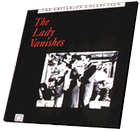

UK suspense
1938
bw 97 min.
Director: Alfred Hitchcock
CLV: $29.95 - taking pre-orders now
1 disc, catalog # CC1104L
DVD: $39.95 - available
1 disc, catalog # LAD120
VHS: available from Home Vision Cinema
In The Lady Vanishes, Alfred Hitchcock pushes the romantic
comedythriller form to perfection. Endlessly imitated, the film remains unique,
even in Hitchcock's canon. In no other movie but North by Northwest was he
able to blend these two genres so perfectly. In the other, similar hybrids, one
element tends to dominate: the suspense in The 39 Steps, the romance in
To Catch a Thief, or the comedy in The Trouble with Harry. Watching
The Lady Vanishes, we're as beguiled by the sparkling repartee of the
lovers Iris and Gilbert and the daft by-play of cricket buffs Caldicott and
Charters as we are riveted by the shocks and stunning plot turns. The central
premise itself is wonderfully adroit: the unaccountably missing governess, Miss
Froy, vanishes on a train where everyone denies she ever existed. This conundrum,
which the intrepid lovers try to unravel, adds another spice; and even though
Hitchcock often insists he was not a maker of mystery stories -- that his concern
was suspense, not surprise -- this plot is a beauty, with an impossible crime and
a gallery of colorful suspects worthy of Agatha Christie or Ellery Queen: an
ingenious enigma that keeps us guessing right up to the moment of revelation.
(Typically for Hitchcock, this occurs with almost a quarter of the movie, and the
two most exciting sequences, still to come.)Adapted by Sidney Gilliat and
Frank Launder from Ethel Lina White's novel The Wheel Spins, the film's
premise has a real-life antecedent: the disappearance of a young woman's brother
during the 1880 Paris Exposition, at a hotel where everyone denied his existence
because he had died of plague. This story was filmed by Terence Fisher in 1950,
as So Long at the Fair. The Lady Vanishes script, written in 1936,
is a clear attack on Britain's isolationist foreign policy under Chamberlain in
the face of threats to Europe. (Indeed, the film's official appeaser, Todhunter,
is shot in the back while trying to surrender.) The villains are obvious Nazi
surrogates. The whole element of international intrigue was added to White's
simple murder mystery by Gilliat and Launder, as well as some astonishingly
irreverent political commentary and many of the characters. The dialogue has a
wonderful snap and savor, a mixture of brash impudence and British understatement
-- and in many ways the triumph of The Lady Vanishes is as much Gilliat's
and Launder's as Hitchcock's. Ironically, despite its close identification with
him, this is one of a handful of his scripts after 1934 that Hitchcock neither
initiated nor worked on extensively. Indeed, it was intended for another
director. Roy William Neill, later responsible for most of the Basil
Rathbone-Nigel Bruce Sherlock Holmes series, was in overall charge when the
second unit commenced location shooting in Yugoslavia in 1936; and he would have
remained, but for a faux pas with the government that resulted in the company's
exile. Hitchcock revived, and recast, the project a year later -- because he
liked the script and because he had one film to go on his Gaumont British
contract. The only major changes he requested were a speeded-up opening, and a
new, more exciting, climax.
Characterization is crucial to the movie. As much
as Stagecoach or Casablanca, this is a film full of people one
remembers and loves. Where could you find a prettier, pluckier, more determined
heroine than Margaret Lockwood's Iris Henderson? Or a shrewder, more
impertinently charming hero than Michael Redgrave's wry young music scholar,
Gilbert? Lockwood, in 1938, was a reigning British box office queen, and Redgrave
was making his film debut; yet they play together with a delicious chemistry that
suggests years of partnership. Where could one find a more suave, worldlier
skeptic than Paul Lukas' Dr. Hartz? Or a more eerily genial magician than Philip
Leaver's Signor Doppo? Or a more sublime pair of aging British public school boys
than Naunton Wayne and Basil Radford's ineffable Caldicott and Charters?
The
Lady Vanishes is an illusionist's trick in which one never really wants to
outguess the trickery. Francois Truffaut, who claimed that he often caught it
twice in a single week, told Hitchcock: "Since I know it by heart, I tell myself
each time that I'm going to ignore the plot (and study the technique and effect).
But each time, I become so absorbed by the characters and the story that I've yet
to figure out the mechanics of the film." Indeed, the film, which begins on an
obvious model set, has some of the toy-like charm of a puppet film or cartoon;
its setting is a fairy-tale land, a Balkan nation seemingly composed of equal
parts of Yugoslavia, Czechoslovakia and even Switzerland (the landscapes were
actually shot in the south of France), through which races a train which is a
conjurer's trick of studio sets, transparencies, miniatures and optical effects.
One doesn't question the train's reality any more than one doubts the existence
of Miss Froy.
The Lady Vanishes represents the acme of Hitchcock's
special brand of humor. Two years later, he was in America, and, though in the
following decades his flair for suspense was heightened, the humor flourished
only in odd segments and his acidulous TV show introductions. The Lady
Vanishes remains the funniest film he ever made. The first time or the
hundredth, the special alchemy of laughs, love and terror keeps its spell. The
lady may vanish, but the movie stays with us always.
-- MICHAEL
WILMINGTON
CREDITS
Director: Alfred Hitchcock
Producer: Gaumont
British
Screenplay by: Sydney Galliat, Frank Launder
Based on the novel by:
Ethel Lina White
Cinematography: Jack Cox
Music: Louis
Levy
TRANSFER
This edition of The Lady Vanishes was transferred
from a 35mm fine grain print made from the original negative.






